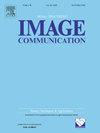一种提高图像质量评价指标精度的新方法:对指标与平均评价分数之间的关系分段线性化
IF 2.7
3区 工程技术
Q2 ENGINEERING, ELECTRICAL & ELECTRONIC
引用次数: 0
摘要
测量感知视觉质量是许多图像和视频处理应用的重要任务。虽然最准确的结果是通过主观评价获得的,但这个过程相当耗时。为了简化这一过程,多年来,许多图像质量评估(IQA)算法使用不同的方法来设计,以考虑人类视觉系统(HVS)的各个方面。评估这些算法的性能通常涉及使用Pearson线性相关系数(PLCC)将其分数与主观分数进行比较。然而,由于客观和主观评分之间的关系往往是固有的非线性,在性能评估之前应用非线性映射,最常见的是由视频质量专家组(VQEG)提出的5参数逻辑函数,是文献中的标准做法。在本文中,我们提出了一种新的分段线性化格式,作为广泛使用的非线性映射函数的替代方案。我们的方法采用数据依赖的分段线性映射来将客观度量分数与主观质量分数对齐,该方法适用于许多不同的IQA度量。我们使用PLCC作为主要性能指标,在三个公开可用的数据集(CSIQ, TID2008, TID2013)和七个不同的IQA指标上验证了所提出方法的有效性。实验结果表明,我们的线性化方法有效地衡量了度量分数,并与主观分数实现了更强的相关性,从而提高了预测精度。复制我们的结果的代码可在github.com/cemremuge/PiecewiseLinearization上公开获得。本文章由计算机程序翻译,如有差异,请以英文原文为准。
A new method to improve the precision of image quality assessment metrics: Piecewise linearization of the relationship between the metrics and mean opinion scores
Measuring the perceptual visual quality is an important task for many image and video processing applications. Although, the most accurate results are obtained through subjective evaluation, the process is quite time-consuming. To ease the process, many image quality assessment (IQA) algorithms are designed using different approaches to account for various aspects of the human visual system (HVS) over the years. Evaluating the performance of these algorithms typically involves comparison of their scores to subjective scores using Pearson Linear Correlation Coefficient (PLCC). However, because the relationship between objective and subjective scores is often inherently nonlinear, applying a nonlinear mapping, most commonly the 5-parameter logistic function proposed by Video Quality Experts Group (VQEG), prior to performance evaluation is a standard practice in the literature. In this paper, we propose a novel piecewise linearization scheme as an alternative to the widely used nonlinear mapping function. Our method employs a data dependent piecewise linear mapping to align objective metric scores with subjective quality scores, which is applicable to many different IQA metrics. We validate the effectiveness of the proposed method on three publicly available datasets (CSIQ, TID2008, TID2013) and seven different IQA metrics, using PLCC as the primary performance indicator. Experimental results show that our linearization method effectively scales metric scores and achieves stronger correlations with subjective scores yielding a higher prediction accuracy. Code to reproduce our results is publicly available at github.com/cemremuge/PiecewiseLinearization.
求助全文
通过发布文献求助,成功后即可免费获取论文全文。
去求助
来源期刊

Signal Processing-Image Communication
工程技术-工程:电子与电气
CiteScore
8.40
自引率
2.90%
发文量
138
审稿时长
5.2 months
期刊介绍:
Signal Processing: Image Communication is an international journal for the development of the theory and practice of image communication. Its primary objectives are the following:
To present a forum for the advancement of theory and practice of image communication.
To stimulate cross-fertilization between areas similar in nature which have traditionally been separated, for example, various aspects of visual communications and information systems.
To contribute to a rapid information exchange between the industrial and academic environments.
The editorial policy and the technical content of the journal are the responsibility of the Editor-in-Chief, the Area Editors and the Advisory Editors. The Journal is self-supporting from subscription income and contains a minimum amount of advertisements. Advertisements are subject to the prior approval of the Editor-in-Chief. The journal welcomes contributions from every country in the world.
Signal Processing: Image Communication publishes articles relating to aspects of the design, implementation and use of image communication systems. The journal features original research work, tutorial and review articles, and accounts of practical developments.
Subjects of interest include image/video coding, 3D video representations and compression, 3D graphics and animation compression, HDTV and 3DTV systems, video adaptation, video over IP, peer-to-peer video networking, interactive visual communication, multi-user video conferencing, wireless video broadcasting and communication, visual surveillance, 2D and 3D image/video quality measures, pre/post processing, video restoration and super-resolution, multi-camera video analysis, motion analysis, content-based image/video indexing and retrieval, face and gesture processing, video synthesis, 2D and 3D image/video acquisition and display technologies, architectures for image/video processing and communication.
 求助内容:
求助内容: 应助结果提醒方式:
应助结果提醒方式:


